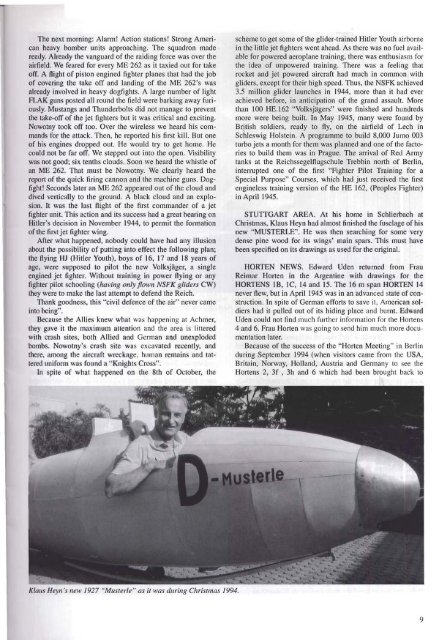No 84 Spring 1995 - Lakes Gliding Club
No 84 Spring 1995 - Lakes Gliding Club
No 84 Spring 1995 - Lakes Gliding Club
Create successful ePaper yourself
Turn your PDF publications into a flip-book with our unique Google optimized e-Paper software.
The next morning: Alarm! Action stations! Strong American<br />
heavy bomber units approaching. The squadron made<br />
ready, Ah'eady the vanguard of the raiding force was over the<br />
airfield. We feared for every ME 262 as it taxied out for take<br />
off. A flight of piston engined fighter planes that had the job<br />
of covering the take off and landing of the ME 262's was<br />
already involved ,in heavy dogfights. A large number of light<br />
FLAK guns posted all round the field were barking away furiously.<br />
Mustangs and Thunderbolts did not manage to prevent<br />
the take-off of dl.e jet fighters but it was critical and exciting.<br />
<strong>No</strong>wotny took on Wo. Over the wireless we heard his commands<br />
for the attack. Then, he reported his first kill. But one<br />
of his engines dropped out. He would try to get home. He<br />
could not be far off. We stepped out into the open. Visibility<br />
was not good; six tenths clouds. Soon we heard the whistle of<br />
an ME 262. That must be <strong>No</strong>wotny. We clearly heard the<br />
report of tile quick firing cannon and the machine guns. Dogfight!<br />
Seconds later an ME 262 appeared out of the cloud and<br />
dived vertically Co the ground. A black cloud and an explosion.<br />
It was the last flight of the first commander of a jet<br />
fighter uni,t. This uGtion and its success had a great bearing on<br />
Hitler's decision in <strong>No</strong>vember 1944, to permit the formation<br />
of the first jet figh(er wing.<br />
After what happened, nobody could have had any illusion<br />
about the possibility of putting into effect the foUowing plan;<br />
the fly,ing HJ (Hitler Youth), boys of 16, 17 and 18 years of<br />
age, were supposed to pilot the new Volksjager, a single<br />
engined jet fighter. Without training in power ftiying or any<br />
fighter pilot schooling (having only flown NSFK gliders CW)<br />
they were to make the last attempt to defend the Reich.<br />
Thank goodness, this "civil defence of the air" never came<br />
into being".<br />
Because the Allies knew what was happening at Achmer,<br />
they gave it the maximum attention and the area is littered<br />
w,ith crash sites, both Allied and German and unexploded<br />
bombs. <strong>No</strong>wotny's crash site Was excavated recently, and<br />
there, among the aircraft wreckage, human remains and tattered<br />
uniform was found a "Knights Cross".<br />
In spite of what happened on the 8th of October, the<br />
Klalls Heyn's new 1927 "Mllsterle" as it was during Christmas 1994.<br />
scheme to get some of the glider-trained Hitler Youth airborne<br />
in the little jet fighters went ahead. As there was no fuel available<br />
for powered aeroplane training, there was enthusiasm for<br />
the idea of unpowered training. There was a feeling that<br />
rocket and jet powered aircraft had much in common with<br />
gliders, except for their high speed. Thus, the NSFK achieved<br />
3.5 million glider launches in 1944, more than it had ever<br />
achieved before, in anticipation of the grand assault. More<br />
than 100 HE. 162 "Volksjagers" were finished and hundreds<br />
more were being built. In May 1945, many were found by<br />
Bl:!tish soldiers, ready to fly, on the airfield of Lech in<br />
Schleswig Holstein. A programme to build 8,000 Jumo 003<br />
turbo jets a month for them was planned and one of the factories<br />
to build them was in Prague. The arrival of Red Army<br />
tanks at the Reichssegelflugschule Trebbin north of Berlin,<br />
interrupted one of the first "Fighter Pilot Training for a<br />
Special Purpose" Courses, which had just received the first<br />
engineless training version of the HE 162, (Peoples Fighter)<br />
in April 1945.<br />
STUTTGART AREA. Af his home in Schlierbach at<br />
Christmas, Klaus Heyn had almost finished Ithe fuselage of his<br />
new "MUSTERLE". He was then searching for some very<br />
dense pine wood for its wings' main spars. This must have<br />
been specified on its drawings as used for the original.<br />
HORTEN NEWS. Edward Uden renurned from Frau<br />
Reimar Horten in the Argentifle with drawings for the<br />
HORTENS IB, le, 14 and 15. The 16 m span HORTEN 14<br />
never flew, but in April 1945 was in an advanced state of-construction.<br />
In spite of German efforts to save it, American soldiers<br />
had it pulled out of its hiding place and burnt. EdwaJ1d<br />
Uden could not find much further information for the Hortens<br />
4 and 6. Frau Horten was going to send him much more documentation<br />
later.<br />
Because of the success of the "Horten Meeting" in Berlin<br />
during September 1994 (when visitors came from the USA,<br />
Britain, <strong>No</strong>rway, Holland, Austria and Germany to see the<br />
Hortens 2, 3f , 3h and 6 which had been brought back to<br />
9

















